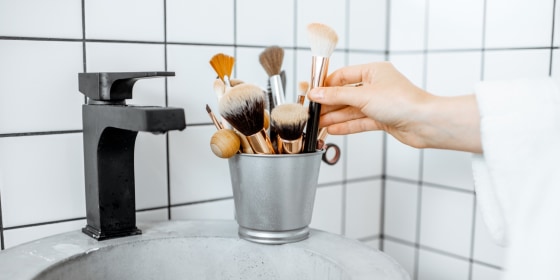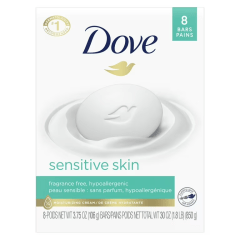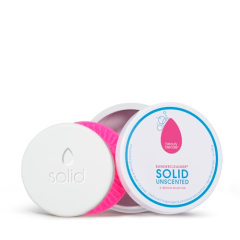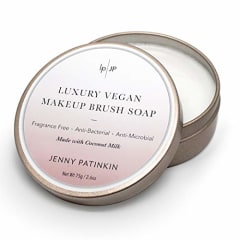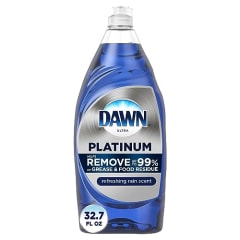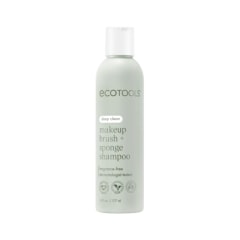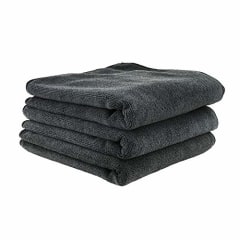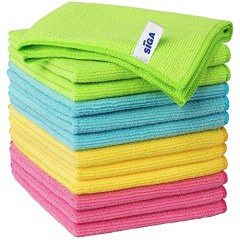I enjoy vacuuming my carpets and making my bed, but one of my least favorite chores is cleaning my makeup brushes. It always seems like such a hassle, plus the 24-hour turnaround of waiting for them to dry is frustrating, especially if I need to do my makeup soon. However, after speaking to celebrity makeup artists, I now understand how essential it is to do on a regular basis.
Not cleaning your brushes can lead to makeup buildup on the brush hairs, which can negatively affect the softness of the bristles over time and lead to a patchy or streaky application, says Eric Vosburg, a New York City-based makeup artist. Also, due to the high moisture content from liquid and cream products, bacteria can easily form and grow, which can cause the contaminated tools to spread around the skin leading to acne, says Vosburg.
To help prevent this, our experts suggest following a simple care routine to clean makeup brushes, sponges and puffs. I also compiled a list of their favorite cleaning agents, including soaps, towels and more as well as NBC Select-staff favorites and highly rated brush cleaners.
SKIP AHEAD How do you clean makeup brushes? | How do you clean makeup sponges? | How do you clean makeup puffs? | Why trust NBC Select?
Want more from NBC Select? Sign up for our newsletter, The Selection, and shop smarter.
How do you clean makeup brushes?
Knowing what your brushes are made of before you clean them is key. Below, Vosburg breaks down the two most common brush hair types:
Generally, many brushes are made of synthetic fibers (you’ll see these in foundation and lip brushes), but removing all the product buildup can be challenging. A simple soap can help break down the oils quickly for these synthetic brushes.
You can find natural hair brushes (powder brushes, eyeshadow brushes and more) made out of several different types of hair but they’re often made with white goat hair. These types of hairs are prone to staining — whether it be from a pigmented blush or other beauty product — and is not something to worry about. When cleaning natural fibers, you’ll want to use a moisturizing soap to ensure the hair stays hydrated and healthy over time.
- Choose your soap. Although you can use liquid dish soap or shampoo, Vosburg likes bar soap because it’s effective and easy to use. “When cleaning with a bar of soap, I will simply wet the tips of the brush hairs with a bit of lukewarm water and then swirl the brush a few times on the bar of soap.”
- Work the soap into a lather. After swirling the brush on the bar soap itself, swirl it into the palm of your hand to work it into a lather. Or, in the case of using liquid soap, squeeze a pea-size amount into the palm of your hands (as it’s more concentrated and goes a long way for any size brush) and work it by gently wiping back and forth, making sure not to push or bend the bristles too harshly, according to Zac Hart, a New York City-based hair and makeup artist. If you’re using baby shampoo, squeeze it into the palm of your hand, but you may need a little more for larger brushes, up to a penny size amount, says Hart.
- Rinse. Run just the brush hairs under the lukewarm water since hot water can damage the hair and loosen the glue that holds them together, according to Hart. It’s essential to reduce the amount of water that comes in contact with the brush ferrule (the metal part that attaches to the brush bristles and the handle). This is because glue and additional binders hold the brush bristles together where the ferrule is. Avoiding dunking or soaking the brush will be very helpful in reducing the shedding of its hair and ensuring the brush’s longevity, according to Vosburg.
- Repeat. You can repeat this as often as needed until the brush is clean.
- Remove excess water and dry. Using a microfiber towel, squeeze the brush hairs to help remove excess water. You can then lay it flat to air-dry. If you’re in a hurry, avoid using a blow dryer because heat can reheat the glue, causing the brush hairs to loosen over time. Instead, take a microfiber towel and gently swirl the brush on the towel until dry.
How do you clean makeup sponges?
Like makeup brushes, you can clean them similarly to sponges, according to Hart.
- Get the sponge wet. Wet the sponge until it becomes saturated, says Vosburg.
- Lather it with soap. Take the sponge and swirl it onto a bar of soap. Once it’s coated with soap, swirl it on the palm of your hand to create a lather, according to Vosburg.
- Rinse. Give the sponge a few squeezes, and then rinse it under warm water until there’s no soap left, says Vosburg
- Repeat. Continue steps two and three until needed. It may take multiple repeats for the sponge to become clean, according to Vosburg.
- Remove excess water and dry. Squeeze any excess water out and let it air dry. You never want to place them in a sealed bag or a space that doesn’t have consistent airflow, says Hart. That’s because sponges retain moisture and will start to grow bacteria and mold if they are unable to air out completely, according to Hart. “I keep my sponges and puffs in a mesh bag, so they’re constantly being aired out while in storage,” he says.
How do you clean makeup puffs?
It’s essential to clean puffs just as often as your sponges and brushes to prevent bacteria and germs from forming, says Hart.
- Get the puff wet. Start by soaking the puff in warm water, according to Hart.
- Lather it with soap. Using either bar soap or baby shampoo, lather the puff. You can treat it like a sponge or brush with bar soap or place a small amount of liquid soap/shampoo in the center of the puff, fold it like a taco, and rub both sides together, according to Vosburg.
- Rinse. Squeeze and rinse the puff under warm water and repeat as needed, says Vosburg.
- Remove excess water and dry. Squeeze out excess water and lay it flat to dry. You can also place your puff on a drying rack you might have in your kitchen or something similar to let air flow all the way around it, says Hart.
Meet our experts
At NBC Select, we work with experts who have specialized knowledge and authority based on relevant training and/or experience. We also take steps to ensure all expert advice and recommendations are made independently and without undisclosed financial conflicts of interest.
- Zac Hart is a New York City-based hair and makeup artist who works on celebrity clients, campaigns and more.
- Eric Vosburg is a New York City-based makeup artist who works on celebrity clients, campaigns, editorial work and more.
Why trust NBC Select?
I’m an associate reporter who covers new product launches, skin care, hair care and more, including recent stories on the best under-eye patches and the best hair masks. For this story, I interviewed makeup artists to find the best ways to clean makeup brushes, sponges and puffs. I also included their recommendations for cleaning products as well as NBC Select-staff favorites that met their guidance.
Catch up on NBC Select’s in-depth coverage of tech and tools, wellness and more, and follow us on Facebook, Instagram, Twitter and TikTok to stay up to date.
